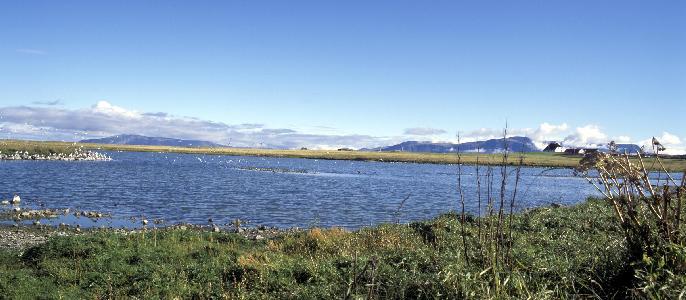Vinna við nýjar heimasíður Umhverfis- og orkustofnunar og Náttúruverndarstofnunar er í gangi. Heimasíða Umhverfisstofnunar er virk á meðan vinnunni stendur. Information in English
Bakkatjorn, Seltjarnarnes

Bakkatjörn was protected in 2000. Bakkatjörn is an ice salt pond and has been that way since 1960 when the clay inlet that was there was closed off. A depression called Rásin (The Channel) once connected Bakkatjörn and Seftjörn, but the latter has now disappeared under urbanization.
The nature reserve covers an area of 14.9 ha.
Bakkatjörn’s Surroundings
Around Bakkatjörn is grassland in sandy soil and wetlands. Species found within the reserve include lyme grass, creeping bentgrass, silverweed, lesser yellow-rattle, marsh arrow-grass, northern dock, Richardson’s fescue, meadow grass, field horsetail, black sedge, marsh foxtail, mare’s tail, narrow small-reeds, Lyngbye’s sedge, lady’s smock, slender spike-rush, scentless mayweed, sea sandwort, sea-rocket, shepherd’s purse, yarrow, tufted hairgrass, Arctic red fescue, golden gentian, serrate gentian, knotted pearlwort, tufted vetch, Alaska grass of parnassus, cold eyebright, common sorrel, autumn hawkbit, meadow buttercup, lady’s mantle, forget-me-not, white clover and many-flowered woodrush. In the wettest streams, mare’s tail, Lyngbye’s sedge, black sedge and white cotton-grass, narrow-leaved cotton-grass, yellow marsh marigold, creeping bentgrass, slender spike-rush, marsh arrow-grass and marsh foxtail grow.
Ecosystem
Recorded bird species in Seltjarnarnes increased by around 28% from 1957–1992. A survey conducted in 1986 revealed that the Arctic tern is the most common bird in the area, around 900 pairs, and thereof around 200 were to the north and east of Bakkatjörn. With the creation of Bakkatjörn around 1960, various species of duck began to make their way to Seltjarnarnes and later began to nest there following changed food conditions. Also taking advantage of the changes in landscape was the red-breasted merganser, a species that had been a common winter visitor on the sea around Seltjarnarnes. Red-necked phalaropes can be seen from mid-May to the latter part of August; in July and August, the birds number in the hundreds on Bakkatjörn and its surrounding area. Bakkatjörn is a bird feeding area, and near it are high-tide roosts and resting spots. It is believed that when the inlet was turned into a pond, there were great changes in animalcule life, as there was now a pond instead of mud.
The picture shows a red-breasted merganser in its winter coat.
Access
General access to the area is allowed provided that visitors conduct themselves properly. During the nesting season, from May 1st – July 1st , traffic through the nature reserve around Bakkatjörn is limited. Dogs are prohibited in the nature reserve.